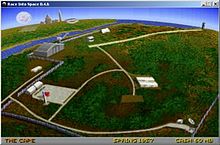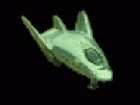
Apollo 11 was the American spaceflight that first landed humans on the Moon. Commander Neil Armstrong and Lunar Module Pilot Buzz Aldrin landed the Apollo Lunar Module Eagle on July 20, 1969, at 20:17 UTC, and Armstrong became the first person to step onto the Moon's surface six hours and 39 minutes later, on July 21 at 02:56 UTC. Aldrin joined him 19 minutes later, and they spent about two and a quarter hours together exploring the site they had named Tranquility Base upon landing. Armstrong and Aldrin collected 47.5 pounds (21.5 kg) of lunar material to bring back to Earth as pilot Michael Collins flew the Command Module Columbia in lunar orbit, and were on the Moon's surface for 21 hours, 36 minutes before lifting off to rejoin Columbia.

Apollo 10 was the fourth human spaceflight in the United States' Apollo program and the second to orbit the Moon. NASA, the mission's operator, described it as a "dress rehearsal" for the first Moon landing. It was designated an "F" mission, intended to test all spacecraft components and procedures short of actual descent and landing.
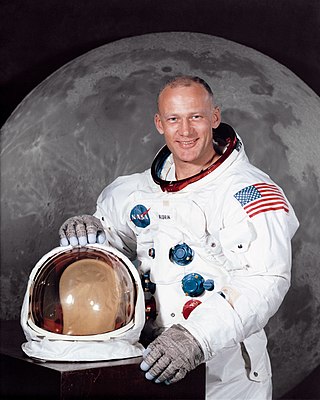
Buzz Aldrin is an American former astronaut, engineer and fighter pilot. He made three spacewalks as pilot of the 1966 Gemini 12 mission. He was the Lunar Module Eagle pilot on the 1969 Apollo 11 mission and became the second person to walk on the Moon after mission commander Neil Armstrong.

Moon landing conspiracy theories claim that some or all elements of the Apollo program and the associated Moon landings were hoaxes staged by NASA, possibly with the aid of other organizations. The most notable claim is that the six crewed landings (1969–1972) were faked and that twelve Apollo astronauts did not actually walk on the Moon. Various groups and individuals have made claims since the mid-1970s that NASA and others knowingly misled the public into believing the landings happened, by manufacturing, tampering with, or destroying evidence including photos, telemetry tapes, radio and TV transmissions, and Moon rock samples.
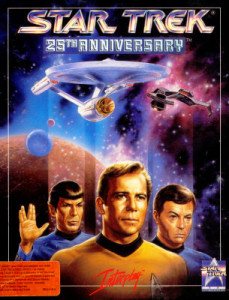
Star Trek: 25th Anniversary is an adventure video game developed and published by Interplay Productions in 1992, based on the Star Trek universe. The game chronicles various missions of James T. Kirk and his crew of the USS Enterprise. Its 1993 sequel, Star Trek: Judgment Rites, continues and concludes this two-game series.

Bart Winfield Sibrel is an American conspiracy theorist who has written, produced, and directed works in support of the false belief that the Apollo Moon landings between 1969 and 1972 were staged by NASA under the control of the CIA. He has written, produced, and directed four independent films promoting the ideas, with the first being the 2001 film A Funny Thing Happened on the Way to the Moon. In his works, Sibrel in part films himself asking that various Apollo astronauts put their hand on the Bible and swear an oath that they walked on the Moon. In the case of the Apollo 11 astronaut Buzz Aldrin, whom Sibrel arranged to meet on a false pretense, outside the Luxe Hotel in Beverly Hills, the interaction resulted in Aldrin punching Sibrel, which brought him significant publicity. However, no criminal charges were filed against Aldrin.

Tranquility Base is the site on the Moon where, in July 1969, humans landed and walked on a celestial body other than Earth for the first time. On July 20, 1969, Apollo 11 crewmembers Neil Armstrong and Buzz Aldrin landed their Apollo Lunar Module Eagle at approximately 20:17:40 UTC. Armstrong exited the spacecraft six hours and 39 minutes after touchdown, followed 19 minutes later by Aldrin. The astronauts spent two hours and 31 minutes examining and photographing the lunar surface, setting up several scientific experiment packages, and collecting 47.5 pounds (21.5 kg) of dirt and rock samples for return to Earth. They lifted off the surface on July 21 at 17:54 UTC.

A Moon landing or lunar landing is the arrival of a spacecraft on the surface of the Moon. This includes both crewed and robotic missions. The first human-made object to touch the Moon was the Soviet Union's Luna 2, on 13 September 1959.
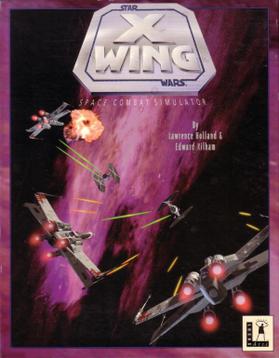
Star Wars: X-Wing is a space simulation video game, the first of the X-Wing combat flight simulation games series. The player's character flies starfighters, including the X-wing, for the Rebel Alliance. The narrative precedes and parallels the events of Star Wars Episode IV: A New Hope.

SpeedScript is a word processor originally printed as a type-in MLX machine language listing in 1984-85 issues of Compute! and Compute!'s Gazette magazines. Approximately 5 KB in length, it provided many of the same features as commercial word processing packages of the 8-bit era, such as PaperClip and Bank Street Writer. Versions were published for the Apple II, Commodore 64 and 128, Atari 8-bit family, VIC-20, and MS-DOS.

Apollo 11 was the first human spaceflight to land on the Moon. The 1969 mission's wide effect on popular culture has resulted in numerous portrayals of Apollo 11 and its crew, Neil Armstrong, Buzz Aldrin, and Michael Collins.

The following outline is provided as an overview of and topical guide to space exploration.

Mars to Stay missions propose astronauts sent to Mars for the first time should intend to stay. Unused emergency return vehicles would be recycled into settlement construction as soon as the habitability of Mars becomes evident to the initial pioneers. Mars to Stay missions are advocated both to reduce cost and to ensure permanent settlement of Mars. Among many notable Mars to Stay advocates, former Apollo astronaut Buzz Aldrin has been particularly outspoken, suggesting in numerous forums "Forget the Moon, Let’s Head to Mars!" and, in June 2013, Aldrin promoted a crewed mission "to homestead Mars and become a two-planet species". In August 2015, Aldrin, in association with the Florida Institute of Technology, presented a "master plan", for NASA consideration, for astronauts, with a "tour of duty of ten years", to colonize Mars before the year 2040. The Mars Underground, Mars Homestead Project / Mars Foundation, Mars One, and Mars Artists Community advocacy groups and business organizations have also adopted Mars to Stay policy initiatives.

The Lunar Flag Assembly (LFA) was a kit containing a flag of the United States designed to be erected on the Moon during the Apollo program. Six such flag assemblies were planted on the Moon. The nylon flags were hung on telescoping staffs and horizontal bars constructed of one-inch anodized aluminum tubes. The flags were carried on the outside of the Apollo Lunar Module (LM), most of them on the descent ladder inside a thermally insulated tubular case to protect them from exhaust gas temperatures calculated to reach 2,000 °F (1,090 °C). The assembly was designed and supervised by Jack Kinzler, head of technical services at the Manned Spacecraft Center (MSC) in Houston, Texas. Six of the flags were ordered from a government supply catalog and measured 3 by 5 feet ; the last one planted on the Moon was the slightly larger, 6-foot (1.8 m)-wide flag which had hung in the MSC Mission Operations Control Room for most of the Apollo program.
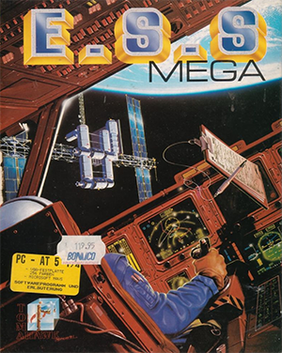
E.S.S Mega is a space simulation game published by Tomahawk and developed by Coktel Vision. E.S.S. Mega recreates ESA's space vehicle concepts of the early 1990, specially the Hermes Shuttle. The game was released for MS-DOS and Atari ST in 1991, and Commodore CDTV in 1992.

Apollo 11 was the first human spaceflight to land on the Moon. In the decades after its 1969 mission took place, widespread celebrations have been held to celebrate its anniversaries.

Command module Columbia (CM-107) is the spacecraft that served as the command module during Apollo 11, which was the first mission to land humans on the Moon. Columbia is the only spacecraft of the 1969 Apollo 11 mission that returned to Earth.

Lunar Module Eagle (LM-5) is the spacecraft that served as the crewed lunar lander of Apollo 11, which was the first mission to land humans on the Moon. It was named after the bald eagle, which was featured prominently on the mission insignia. It flew from Earth to lunar orbit on the command module Columbia, and then was flown to the Moon on July 20, 1969, by astronaut Neil Armstrong with navigational assistance from Buzz Aldrin. Eagle's landing created Tranquility Base, named by Armstrong and Aldrin and first announced upon the module's touchdown.
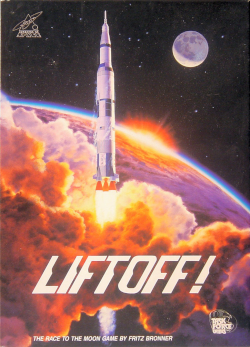
Liftoff! is a board game published by Task Force Games in 1989 that simulates the international space race to land astronauts on the moon during the mid-20th century.

